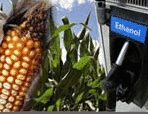Ethanol is a renewable, domestically produced transportation fuel. Whether used in low-level blends, such as E10 (10% ethanol, 90% gasoline), or in E85 (a gasoline-ethanol blend containing 51% to 83% ethanol, depending on geography and season), ethanol helps reduce petroleum use in transportation and greenhouse gas (GHG) emissions. Like any alternative fuel, there are some considerations to take into account when contemplating the use of ethanol.
A gallon of ethanol contains less energy than a gallon of gasoline. The result is lower fuel economy when operating your vehicle.

